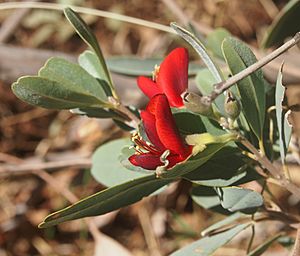Wallflower poison facts for kids
Quick facts for kids Wallflower poison |
|
|---|---|
 |
|
| Scientific classification | |
| Kingdom: | |
| (unranked): | |
| (unranked): | |
| (unranked): | |
| Order: | |
| Family: | |
| Genus: | |
| Species: |
G. grandiflorum
|
| Binomial name | |
| Gastrolobium grandiflorum |
|
The Gastrolobium grandiflorum, also known as wallflower poison or heart-leaf poison bush, is a type of bushy plant. It is found only in Australia, meaning it is endemic there.
This plant can grow to be 2 or 3 metres tall. From late summer to early winter (February to August in Australia), it blooms with bright orange-red flowers. These flowers look like peas and have a yellow center with red veins. Younger plants have hairy, heart-shaped leaves. Older plants have smoother, oval-shaped leaves. These leaves can be up to 6 centimetres long and 2.7 centimetres wide.
The plant was first officially described by a botanist named Ferdinand von Mueller. He wrote about it in his book Fragmenta Phytographiae Australiae in 1863. This plant is the most common type in its group, Gastrolobium. It grows across a large part of Queensland, and also in the Northern Territory, Western Australia, and South Australia.
Why is Wallflower Poisonous?
The wallflower poison plant, like many others in its family, has a special defense. It contains high levels of a natural chemical called fluoroacetate. This chemical is the main ingredient in a pest control substance known as 1080.
The leaves, seeds, and roots of this plant are very poisonous to farm animals. This includes cattle, sheep, horses, and goats. In Queensland, this plant has caused many losses of livestock for farmers.
A Historical Story
In 1896, an explorer and gold prospector named David Carnegie found this plant in Western Australia. He was on his way back from an expedition. He later wrote about his experience:
- He saw beautiful green plants and grass along a creek.
- There was a very inviting-looking plant, about six feet tall.
- It had greenish-grey stems and leaves, and flowers that looked like wallflowers.
- Carnegie thought it would be a good place to camp and unload their animals.
- But his friend Godfrey said the pretty plant looked like a very deadly poison plant from Queensland.
- Carnegie had never seen it before, and neither had another friend, Breaden.
- The risk was too high; it might be poison.
- Carnegie saw his camels looking at the fresh plants, and knew they would eat them quickly.
- So, they packed up and moved on, even though everyone was very tired.
- Carnegie collected some samples of the plant. He realized that if Godfrey hadn't known about it, they would have been in big trouble.
Protecting Farm Animals
This plant is so harmful to farm animals that cattlemen in north-western Queensland take special care. After bushfires, they must move their livestock away. This is because the heart-leaf poison bush grows back quickly from the ashes. If the animals eat it, they can get very sick.

